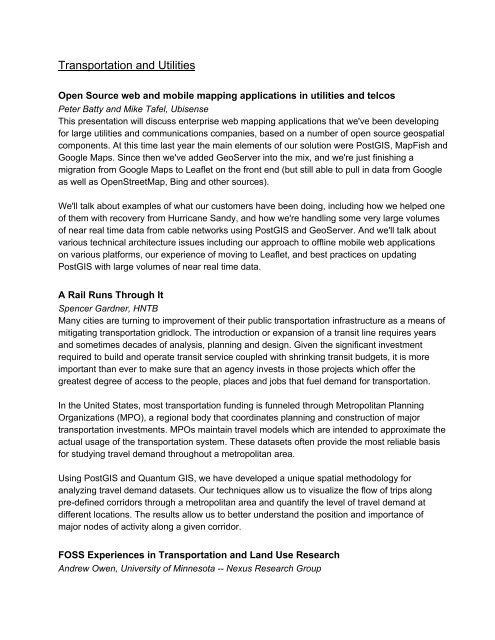FOSS4G North America Conference 2013 Preliminary Program
FOSS4G North America Conference 2013 Preliminary Program
FOSS4G North America Conference 2013 Preliminary Program
Create successful ePaper yourself
Turn your PDF publications into a flip-book with our unique Google optimized e-Paper software.
Transportation and Utilities<br />
Open Source web and mobile mapping applications in utilities and telcos<br />
Peter Batty and Mike Tafel, Ubisense<br />
This presentation will discuss enterprise web mapping applications that we've been developing<br />
for large utilities and communications companies, based on a number of open source geospatial<br />
components. At this time last year the main elements of our solution were PostGIS, MapFish and<br />
Google Maps. Since then we've added GeoServer into the mix, and we're just finishing a<br />
migration from Google Maps to Leaflet on the front end (but still able to pull in data from Google<br />
as well as OpenStreetMap, Bing and other sources).<br />
We'll talk about examples of what our customers have been doing, including how we helped one<br />
of them with recovery from Hurricane Sandy, and how we're handling some very large volumes<br />
of near real time data from cable networks using PostGIS and GeoServer. And we'll talk about<br />
various technical architecture issues including our approach to offline mobile web applications<br />
on various platforms, our experience of moving to Leaflet, and best practices on updating<br />
PostGIS with large volumes of near real time data.<br />
A Rail Runs Through It<br />
Spencer Gardner, HNTB<br />
Many cities are turning to improvement of their public transportation infrastructure as a means of<br />
mitigating transportation gridlock. The introduction or expansion of a transit line requires years<br />
and sometimes decades of analysis, planning and design. Given the significant investment<br />
required to build and operate transit service coupled with shrinking transit budgets, it is more<br />
important than ever to make sure that an agency invests in those projects which offer the<br />
greatest degree of access to the people, places and jobs that fuel demand for transportation.<br />
In the United States, most transportation funding is funneled through Metropolitan Planning<br />
Organizations (MPO), a regional body that coordinates planning and construction of major<br />
transportation investments. MPOs maintain travel models which are intended to approximate the<br />
actual usage of the transportation system. These datasets often provide the most reliable basis<br />
for studying travel demand throughout a metropolitan area.<br />
Using PostGIS and Quantum GIS, we have developed a unique spatial methodology for<br />
analyzing travel demand datasets. Our techniques allow us to visualize the flow of trips along<br />
predefined corridors through a metropolitan area and quantify the level of travel demand at<br />
different locations. The results allow us to better understand the position and importance of<br />
major nodes of activity along a given corridor.<br />
FOSS Experiences in Transportation and Land Use Research<br />
Andrew Owen, University of Minnesota Nexus Research Group


